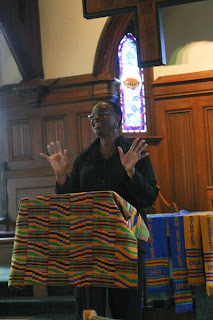The Pan-African Studies Department held its annual Research-in-Progress Presentations on April 12. This event served as a platform for eight students enrolled in the capstone course, to present their works-in-progress and receive suggestions as well as feedback. Professor of History and African-American/African Studies Lillie Edwards said that the presentations served as “a tribute to the students at Drew and the students within the major and minors as well as a great example of their [the students’] commitment to scholarship.”
All students provided thorough, detailed work in progress with invigorating topics ranging from monochromatic friendships, stereotypical ethnic comedy, education, media perceptions and misconceptions to the construction of multiculturalism, the African American church and African American Literature.
The first presenter, Julian Wamble (’11), wrote “Monochromatic Camaraderie: An Analysis of Black and White Friendships” which focused on the concept, or rather pattern, of friendships presented within the media. This interested Wamble for the simple fact that in television shows, the topic of race is not blatantly mentioned. It is as if the construction of race ceases to exist within this realm of media—for example, in cartoons—and the only thing that matters most importantly is shared interests. Julian is interested in looking at the dynamics of friendships between blacks and whites and how these interactions influence their perception and actions within the world. Most importantly, he wanted to examine how these friendships affect how one views affirmative action. Using statisical models and theories, Wamble concluded, “Whites who have black friends are much more inclined to have more positive attitudes about affirmative action than whites without black friends.”
Next, The Acorn’s retired Editor in Chief Sheryl McCabe (’11) presented “Blindly Laughing: Analyzing Stereotypes in Comedy” in which she examined the fine line between humor and blatant misconceptions of race within the works of famous comedians. For her presentation, she interviewed three different Drew students to see how these jokes affect them.
One joke that McCabe examined was from George Lopez, who spoke about women beating their kids. Within the joke, the Hispanic mother is racialized as the professional, where the white mother is an amateur because she gets caught. McCabe found out that in 2003, according to the U.S. Department of Health, percentage-wise the abuse of children is pretty much the same, yet the misconceptions are skewed. McCabe attempted to debunk the stereotypical myths and explain why these notions exist using statistics and surveys.
Presenting “Integrating the Curriculum: A History of the New Jersey Amistad Curriculum”, Samuel Bryson- Brockman (’11) explored the New Jersey implementation of the Amistad Commission which educates students about African American contributions to history. He declared that “our education system continues the cycle of oppression, telling students, at times indirectly, that their history, the history of the United States, has shown that they will not amount to much more than their ancestors were often portrayed in subservient roles.” Brockman argues that the slave narrative is just as important as the master and should be taught to present a clear depiction of history. He revealed that in 2002 the State of New Jersey noticed this problem and how it affected the students, primarily students of color, and implemented the Amistad Curriculum. Nicole McClear (’11) incorporated elements of poetry and dance into her presentation of “Behind the Veil: Cultural Perceptions of Black Women in the Media,” where she examines how the media shapes the perceptions of the identity of the black woman. For her research, she talked to family members and adolescent girls. She looked at the misconceptions of black women represented through music videos and how television shows depicted the black woman, as well as her complexity.
McClear added a dash of artistic expression when she recited her own poem, “Black Woman” and dances to Four Women, written by Nina Simone, performed by singers Kelly Price, Marsha Ambrious, Lesidi and Jill Scott. Erin Hennessey (’12) presented “From a Positive Conception to the Modern Day Nightmare: Post Civil Rights Construction of Multiculturalism and Colorblindness” and examined the Civil Rights Era and its affect on contemporary America. She argued that the reason why racism is continued is because it can be repeated, and she examined negative dialogue that reflects new racism.
Arvolyn Hill (’11) wrote, “Whose Story is it Anyway? Portrayals of Black Women in Tyler Perry and Spike Lee Movies” which examines the ethnic notions of black women represented in the works of Spike Lee and Tyler Perry, despite their different aesthetics.

